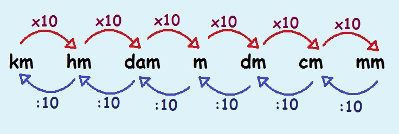In Brazil, we use some main and standardized measurements, such as the meter, but we also often see the millimeter, centimeter and kilometer being used. Units that are smaller than the meter are called metro submultiples, and the larger units are called multiples of the metro.
The multiples of the meter are: Kilometer (Km)
Hectometer (Hm)
Decameter (Dam)
Submultiples of the meter are: Decimeter (Dm)
centimeter (cm)
Millimeter (Mm)
Have you ever noticed that on a ruler we have measurements in centimeters and millimeters? See the figure below, it has a representation of a ruler. Larger lines represent centimeters, and smaller lines represent millimeters. Between two centimeter strokes, there are 10 millimeter traces. We can then say that a centimeter fits 10 millimeters or that 10 millimeters is the same as 1 centimeter.

On the ruler we clearly see that 1 cm is equal to 10 mm
To make transformations between units of length, we can use the idea of this small table:

With this small table, we can transform a measure of length
For example, if we have a length of 15 kilometers and we want to express it in meters, we should look at the arrows. The arrows that lead from km for m are the red ones. Three red arrows with beads of x10. Therefore:
15 km = 15 x 10 x 10 x 10 = 15 x 1000 = 15,000 m
Likewise, we can transform six meters into centimeters. For this transformation, two red arrows indicating x10. Then:
6 m = 6 x 10 x 10 = 6 x 100 = 600 cm
If we want to do the opposite, transforming, for example, 5,000 millimeters to meters, we need three blue arrows indicating :10. Therefore:
5,000 mm = 5,000 : 10: 10: 10 = 5.000: 1000 = 5 m
Let's solve the initial question of the text, 22 cm is equal to 220 mm and 0.00022 km?
Changing 22 cm to millimeters requires a red arrow indicating x10, then:
22 cm = 22 x 10 = 220 mm
Passing 22 cm to kilometers, five blue arrows are needed, indicating :10 each one of them. Therefore:
22 cm : 10: 10: 10: 10: 10 = 22 : 100.000 = 0.00022 km
Therefore, all information about the initial problem in the text is correct, that is:
22 cm = 220 mm = 0.00022 km
By Amanda Gonçalves
Graduated in Mathematics

